Catalogue 2023-2024
Below, browse the 2023-2024 Rencontres Internationales catalogue, or search the archives of the works presented since 2004. New video clips are routinely posted and the images and text are regularly updated.


(la)horde
GHOSTS
Fiction expérimentale | hdv | couleur | 8:12 | France | 2022
Ghosts, le dernier film de (LA)HORDE avec le Ballet national de Marseille, dont la musique est composée par Rone et le scénario par Spike Jonze, nous plonge au coeur du Palais Longchamp, à Marseille. À la fermeture des portes, des figures investissent le musée des Beaux-Arts, s’étreignent et se déchirent, comme pour reprendre corps, jusqu’à leur rencontre avec le gardien de nuit.
À la direction du CCN Ballet national de Marseille depuis 2019, (LA)HORDE réunit depuis 2013 les artistes Marine Brutti, Jonathan Debrouwer et Arthur Harel. À travers des films (Novaciéries, 2015 ; Cloud Chasers, 2016 ; The Master’s Tools, 2017 ; Cultes, 2019 ; Room With A View, 2020 ; Ghosts, 2021) des performances et pièces chorégraphiques, (LA)HORDE interroge la portée politique de la danse et cartographie les formes chorégraphiques de soulèvement populaire, explorant des nouvelles dynamiques de circulation et de représentation de la danse et du corps qui se développent en ligne. Créée avec l’artiste RONE en 2020, Room With A View est leur première pièce chorégraphique avec le Ballet national de Marseille, aujourd’hui composé de 27 danseur·euse·s de 16 nationalités. L’année suivante, iels invitent 4 chorégraphes pour un programme mixte : Lucinda Childs, Tânia Carvalho, Lasseindra Ninja and Oona Doherty, chacune incarnant une écriture chorégraphique emblématique, inclusive et engagée. En 2022, iels présentent Roommates, un programme de 6 pièces courtes signées Lucinda Childs, Claude Brumachon et Benjamin Lamarche, Peeping Tom, Cecilia Bengolea et François Chaignaud, (LA)HORDE, ainsi qu’une grande exposition dansée, We Should Have Never Walked on the Moon mêlant le registre de la comédie musicale et du cinéma d’action avec celui de l’avant-garde chorégraphique.


Lynne A. Sachs
Swerve
Doc. expérimental | super8 | couleur | 7:0 | USA | 2022
A market and playground in Queens, New York, a borough of New York City, become the site for the shooting of a film inspired by Paolo Javier’s Original Brown Boy poems. Wearing the tell-tale masks of our daunting now, five New York City performers search for a meal while speaking in verse. The film itself transforms into an ars poetica/ cinematica, a meditation on writing and making images in the liminal space between a global pandemic and what might come next.
Lynne Sachs is a filmmaker and poet. Over the last three decades, she has created cinematic works that defy genre through the use of hybrid forms and cross-disciplinary collaboration, incorporating elements of documentary, performance, and collage. Her films explore the intricate relationship between personal observations and broader historical experiences, often from a personal, self-reflexive point of view. With each project, Sachs investigates the implicit connection between the body, the camera, and the materiality of film itself. Sachs’ early works on celluloid offer a feminist approach to the creation of images and writing— a commitment which has grounded her vision ever since. Her films have screened at the Museum of Modern Art, Wexner Center for the Arts, the Walker and the Getty. Retrospectives of Sachs’ work have been presented at the International Short Film Festival Oberhausen, Sheffield Doc/Fest, Buenos Aires International Festival of Independent Cinema, Festival International Nuevo Cine in Havana, Cork, and China Women’s Film Festival. Lynne lives in Brooklyn. Her work is represented by internationally by Kino Rebelde and is part of the Light Cone Catalogue in France.


Sunder Aarti
Ghost Cut: Some Clear Pixels Amongst Many Black Boxes
Vidéo | mov | couleur | 22:11 | Inde | 2021
This film draws from conversations with Amazon Mturk workers and their relationship with the politics of the Mechanical Turk platform – the varying forms of transparencies and opacities that make the platform what it is. Focusing on the backend of AI and machine learning processes, the film investigates the relationships between the analogic, the digital and the terrestrial. What kind of work is required for smooth functioning of automation? Who does this backend work, where does it take place, and what does it entail? Using the very processes that workers help train on online platforms as material, recursions of different scales takes place, where we see language, the ability to define and speak clear English as central. A second focus is an exploration of the subjective nature of data gathering, processing and annotating, and the material infrastructures it is dependent on. In the absence of any fixed constants, context or averages, abstraction emerges as an important and forced tool.
Aarti Sunder’s research and practice lies at the crossroads of the digital humanities and contemporary art. She is interested in the fictions arising from investigating situated experiences and asking if these help us re-think the ways in which we understand technology and our relationship with it. So far she has focused on contemporary labour practices, fictional edges of protest, myth and digital-terrestrial play. Aarti’s interest is to problematize the determined linearity of ‘progress’ inscribed within the promise of the algorithm, technological prowess and a quantifiable future. Looking at globalised framework of precarious labour, non-human exhaustion and storytelling that lies at the strategic intersection of power, knowledge and aesthetics. Relooking at these intersections, she believes, can help us tell better stories, of fictions past, present and future. Among other places, Aarti will exhibit her work at the forthcoming 67th BFI London Film Festival and in collaboration with Doreen Mende at Albertinum of the State Collections of Art in Dresden. She has previously shown at Akademie der Kunst, Singapore Biennale 22, Hayy Jameel, MIT, Warehouse421, the Goethe Institute in Chicago, Kunstverein Leipzig, Bauhaus Imaginista, Alserkal Avenue, Ashkal Alwan, ISCP and the Museum of Yugoslav History. She has been the recipient of many grants and fellowships from MIT, Sommerakademie Paul Klee, Harvard FSC Film Center, Art Dubai and Ashkal Alwan and the Sharjah Art Foundation. Aarti Sunder works with video, drawing and text and sculpture.


Sherko Abbas
Silence Along the River
Doc. expérimental | mp4 | couleur | 7:0 | Iraq | 2021
In 1985 a group of Kurdish fighters, known as a "Peshmerga", on a mission to attack one of the army’s camps in the north of Iraq. They took the Sirwan river by a small raft to cross the area which was controlled by the Iraqi army. This footage is part of an old archive taken by my father Abbas Abdulrazaq, a former Kurdish fighter and cameraman. He accompanied this group of Peshmerga to document their activity during the mission. Despite all the risks they have taken, the battle didn’t happen. Consequently, my father filmed them when they were singing a song. I was very intrigued by his action, so I asked my father why this particular footage never showed before? He mockingly replayed who wishes to watch a film that has no fighting scenes?
Sherko Abbas is a Kurdish-Iraqi artist. He was born in Iran in 1978, where his family lived as refugees. They returned to Iraq when he was two years old. Abbas studied Fine Art in Sulaymaniyah, Iraq and earned a Master of Fine Arts degree from Goldsmiths College, University of London in 2015. His work explores sonic and visual memory, with a focus on modern memory that relies on recorded materials. Additionally, Abbas is interested in the current geopolitical situation in Iraq. Abbas’ works have been exhibited and screened internationally including at: Archaic, the Iraq pavilion at the 57th Venice biennale; Theater of Operations, MoMA PS1, New York; May Flames Pave the Way for You, Arsenal gallery, Bia?ystok; Push Festival, Manchester , UK; Towner International, Towner Eastbourne, Eastbourne; Speaking Across Mountains, Middle East Institute, Washington D.C.; Baghdad Mon Amour, Institut des Cultures d’Islam, Paris; Vernacularity, Alternativa Festival, Gdansk; Estrangement, The Showroom, London. Also, his moving image works were screened at the Independent Iraqi Film Festival's online screening, the 38th Kassel Documentary Film and Video Festival in Kassel, Germany, Aashra, Ashkal Alwan Online Film, Rencontres Internationales Paris/Berlin at the Louvre Auditorium in Paris, the Open City Documentary Combined Programme: What Rules The Invisible in London, Visit Festival Het Bos Ankerrui 5-7 in Antwerp, Belgium, Ruya Shop in Baghdad, and Shasha Movies online streaming. Abbas also works as a curator, organizer, and coordinator of cultural events. He was the operations manager for the "Post-war Culture in Iraq" project (2010) and curated the Clamour project (2016). In collaboration with curator Aneta Szy?ak, he researched and coordinated the "In-between Worlds: Kurdish Contemporary Artists" project. This resulted in a collection of artworks from over 30 Kurdish-Iraqi artists and a book. The collection is now part of the Imago Mundi collection under the auspices of the Fondazione Benetton Studi Ricerche in Treviso, Italy.


Soufiane Adel
Le jour où j étais perdu
Fiction expérimentale | 8k, 6k, 4k | couleur | 29:0 | France | 2022
Synopsis : La sonde Voyager s’apprête à quitter notre système solaire. Au même moment, sur Terre, Alain Diaw commence son premier jour de travail dans une grande entreprise automobile. Il revient de loin, et vise lui aussi l’inconnu.
Soufiane Adel est né en 1981 en Algérie et arrive en France à 8 ans. C'est en faisant une école de design, l'ENSCI - Les Ateliers, qu'il découvre le cinéma. En 2004, il décide de filmer son père : ce sera son premier court métrage, NUITS CLOSES, qui débutera au festival de Clermont-Ferrand. En 2007, il réalise KAMEL S’EST SUICIDÉ SIX FOIS, SON PÈRE EST MORT, sélectionné à la Quinzaine des Réalisateurs et à l'ACID à Cannes en 2008. En 2009, il coréalise avec Angela Terrail, SUR LA TÊTE DE BERTHA BOXCAR, prix du jury au festival Silhouette, montré mondialement et diffusé sur Arte. En 2013, il réalise son second documentaire GO FORTH, qui aborde l'histoire de sa grand-mère algérienne, projetés dans des dizaines de festivals internationaux. Son exploration de formes fictionnelles d'auto-filmage se poursuit avec VINCENT V » et LES BONNES. En 2017, il met de nouveau en scène son père dans une fiction, LA FAIM, puis dans l’essai LA LUMIÈRE TOMBE. Son dernier court-métrage LE JOUR OÙ J’ÉTAIS PERDU, interprété par Souleymane Sylla et Damien Bonnard, débute en compétition au IFFR Rotterdam et au Festival international du court-métrage de Clermont-Ferrand.


Kim Richard Adler Mejdahl
Kom Så Molly
Film expérimental | digital | couleur | 21:0 | Danemark | 2022
Rokko and Bobbi visits world-famous psychoanalyst Molly for the first time. The dog couple reveal problems with PTSD and childhood trauma, manifested as symptomatic carpet wetting and an amputated sex life. But through the teachings of Goethe’s color theory, Molly brings the couple on a hypnotic, and transformative love journey.
Copenhagen-based visual artist, experimental filmmaker, and electronic music composer Kim Richard Adler Mejdahl was born in the Danish village Skælskør. He has created a wide range of critically acclaimed artworks that blends genres and media in order to create intricate, bizarre, and sometimes humourous works which resolve around dissolving memory, trauma, and eco-gothic fantasies. Mejdahl holds a master’s degree from The Royal Danish Academy of Fine Arts. Within few years, Mejdahl has created a wide range of exhibitions at art institutions, and his film works have reached international audiences with screenings in Europe and Asia. Working cross-disciplinary, Mejdahls project often combine different fields of art. His recent solo exhibition 'One! More! Time!" at Kunsthal Rønnebæksholm in Denmark centered around a surprising collaboration with the Danish amusement park BonBon-Land. In 2018, Mejdahl received the Charlottenborg Spring Exhibition’s Solo Award for his film 'Ode' — an experimental documentary dealing with the killing of the artist’s abusive father. The film was later acquired by The National Gallery of Denmark.
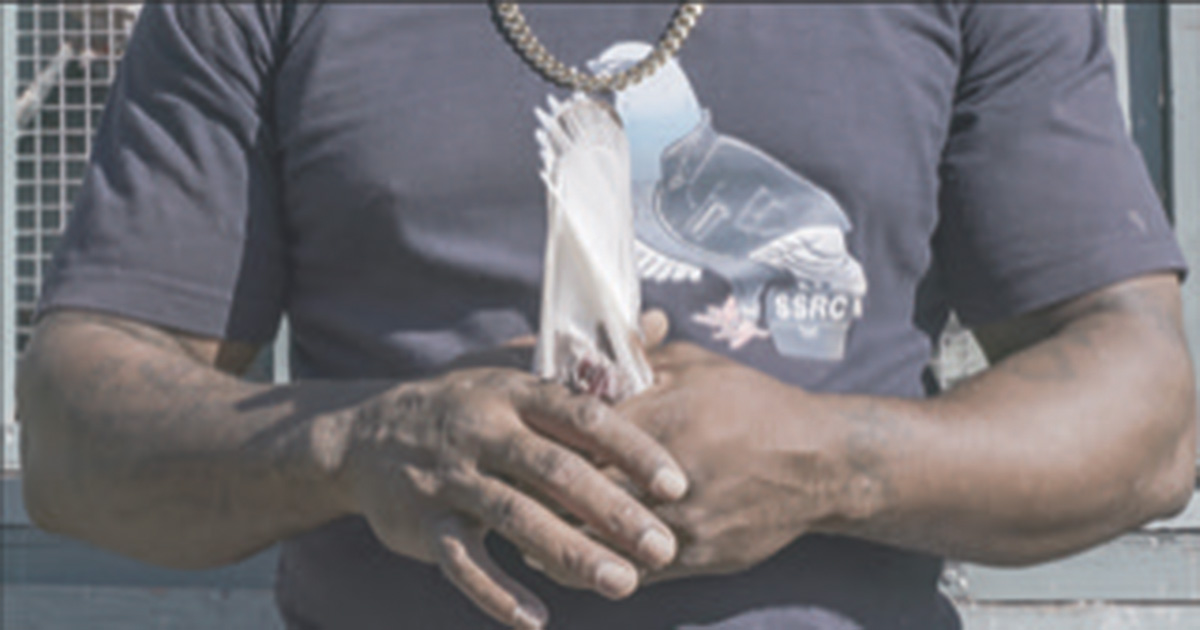

Yalda Afsah
SSRC ( Secret Society Roller Club)
Documentaire | 4k | couleur | 20:0 | Allemagne | 2022
A group of men is fixing their eyes onto the sky. High above, a swarm of pigeons is moving in an unrecognizable formation, when suddenly individual birds drop in mid-air, spinning backwards with their wings extended and tumbling down in a circular motion before resuming their ordinary flight path. Yalda Afsah’s short film SSRC slowly dissects this aerial choreography, revealing its nature as a form of animal training and gradually zooming into the at times almost intimate details of this interspecies relationship. Focusing on the specific social context of the Los Angeles-based „Secret Society Roller Club“ and its members’ identification with and through the animals, Afsah’s film negotiates positions of co-dependency and care, domestication and dominance – calling into question the ambivalence reflected in the symbol of the soaring bird free in its flight, yet simultaneously bound to human will.
German-Iranian artist and filmmaker Yalda Afsah (b. 1983, Berlin) explores how space can be cinematically constructed as her films profoundly explore the interface between reality and staging. This formal characteristic of Afsah’s work is conceptually mirrored in her recent portraits of human-animal relationships that reveal an ambivalence between care and control, physical strength and broken will, instinct and manipulation. Despite their documentary focus, her films and video installations seem to capture symbiotic choreographies on screen – equally portraying and fictionalising their human and non-human protagonists. Afsah has presented her work at various exhibitions and festivals including Manifesta 13, Locarno Film Festival, New York Film Festival, Berlinische Galerie, Institute of Contemporary Arts London, Neuer Berliner Kunstverein and recent solo exhibitions at Kunstverein München and Halle für Kunst Steiermark. Since 2019 she is a mentor for the Berlin program for artists (BPA).


Sandro Aguilar
O Teu Peso Em Ouro
Fiction | hdv | couleur | 26:0 | Portugal | 2022
Oscar, a renowned hypnotherapist, takes advantage of the last moments in his hotel room to say goodbye to the dazzling Mercedes and relieve old Norberto of his sorrows
Born in 1974 in Portugal, Sandro Aguilar studied film at the Escola Superior de Teatro e Cinema. In 1998, he founded the production company O Som e a Fúria. His films have won awards at festivals such as La Biennale di Venezia, Locarno FF, Gijón, Oberhausen,Vila do Conde, Indielisboa FF and have been shown in the most relevant film festivals worldwide. Two times nominated for the EFA – Best European Short Film Award. Retrospectives of his work have been programmed at Rotterdam IFF, BAFICI, New York Film Festival, Arsenal-Berlin and Oberhausen FF. In 2013, he was invited into the renowned DAAD Artist Residency, Berlin
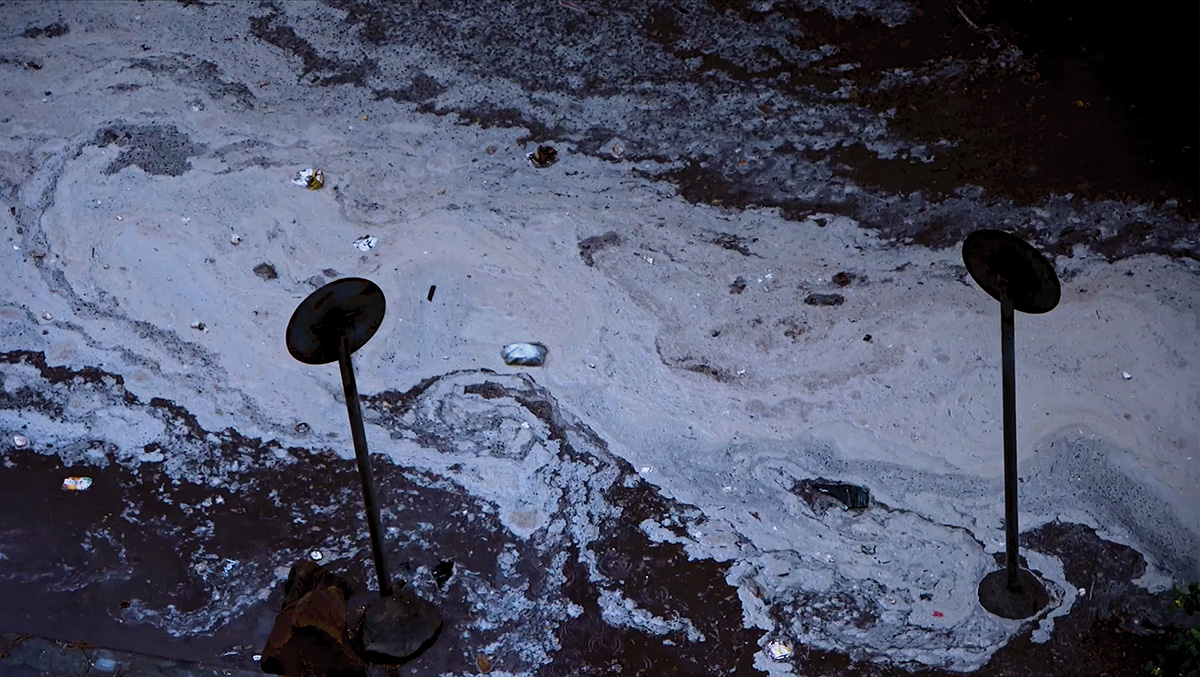

Noureldin Ahmed
Letters of Confinement
Doc. expérimental | digital | couleur et n&b | 20:0 | Egypte | 2021
The Letters of Confinement is an essay film filmed entirely within the confinement of the filmmaker’s house during the quarantine. The first half of the film covers the story of creation according to the the ancient Egyptian genesis. The second half introduces the counter-narrative of creation based on a poem by Ibn Al-Farid, A Sufi master. The film goes on to cover stories like the deluge, the annual inundation, the nature of names, and perversions dictated by the confinement, like voyeurism and eavesdropping. During the documentation process, the surroundings work in accordance to the will of the filmmaker as if the exterior reflects his interior desires. The film follows a collage-like format. Collecting different stories and unrelated footage within the frame of the film. In doing so, an alternative narrative is created where fiction and reality overlap.
Noureldin Ahmed is an independent filmmaker, film curator, translator and visual artist; born, raised and based in Cairo, Egypt. He studied Media Design at the faculty of Applied Arts and Sciences at the German University in Cairo. In his work, Nour questions the notion of self identity within the urban context, namely in Cairo, opening up his self-centered pieces to public viewership and interpretation. Nour has participated in a number of group exhibitions in the past years. His first film, Summertime Dreams, was screened at Ismailia International Film Festival for Shorts and Documentaries in 2019. In 2020 he held his first solo exhibition, A Self-Portrait with a Halo and a Pomegranate. Nour is one of the recipients of a number of grants, including: The Self Organization Grant from Mophradat, 2021, and On the Road Again, Again from Pro Helvetia Cairo, 2022. He is a member of a cinematic collective, A Kiss in the Desert, and a research group, cifrcifrcifr. He worked as a programmer & programme co-ordinator for the short film competition at Cairo International Film Festival, a coordinator of the Arabic publications at Gouna Film Festival, in addition to working as an assistant director, assistant producer, editor and translator. Nour is currently undertaking his master's degree in Film and Screen Studies at the University of Cambridge, UK.


Peggy Ahwesh, Jacqueline Goss
OR119
Vidéo expérimentale | hdcam | couleur | 61:0 | USA | 2022
OR119 is a theoretical musical based on the ideas of radical psychologist Wilhelm Reich who, as Freud’s favorite student, centered his study on the intersections of psychoanalysis and Marxism. Reich’s best work advocates for a re-imagining of family structure and gender roles, sexual liberation for younger people and the working poor and a deep understanding of the effect of fascisms on the body. OR119 is based on quotations by Reich set to song and also in imaginary conversations between Reich and a number of contemporary feminist thinkers. With a group of women friends in improvisation, we playfully examine the unsettled legacy of Reich and his surprisingly relevant dynamic with feminist thought. Reich proposed Orgone, a universal life energy (akin to Chi) based on sex and positive expression that Reich claims to have discovered, and here we grant him the honor of the next number on the periodic chart (OR119) for his discovery. The musical resonance and vibrations of the voices in song make manifest the invisible positive energy that Reich believed was universal. This is by no means a bio-pic! but it is a celebration of life's potential for immersion in nature, the cosmos and interactive energy.
PEGGY AHWESH has worked since the 70's in wide range of technologies and styles in an inquiry into feminism, cultural identity and genre. Featured in the Whitney Biennial (1991, 1995, 2002). Solo exhibitions include: Spike Island (2021); Kunsthall Stavanger (2022); Cleave (2019) Microscope Gallery, New York. Film retrospectives: Anthology Film Archives/NYC, Guggenheim Bilbao/Spain, New Media Fest Seoul/Korea, BFI/London and others. Ahwesh is Emeritus Professor from Bard College and al-Quds Bard College, West Bank, Palestine, where she taught media production and history. Collaborator JACQUELINE GOSS makes movies and web-based works that explore how political, cultural, and scientific systems change our sense of self through animation and live action in documentary and essay forms. Her work has shown at Eyebeam Atelier, The Wexner Center for the Arts and festivals in New York, London, Rotterdam. Goss has received awards from the Tribeca Film Institute, Creative Capital Foundation, the Rockefeller Foundation, Jerome Foundation, Herb Alpert Foundation, the United States Artist Award and the Berliner Kunstlerprogramm. Her videos are distributed by Video Data Bank in Chicago. She teaches Media at Bard College


Shahi Aj
Letters Unwritten To Naiyer Masud
Doc. expérimental | digital | couleur et n&b | 63:37 | Inde | 2022
A pilgrimage taken by a group of readers to the ancestral house of a writer (a house that haunts all of his stories ) nested in the heart of a city , turns into an exploration of the city , into an exercise in mapmaking…into a hallucinatory encounter with the real. Told through the eyes of a stranger, a newcomer, walking through a modern bustling city, blanketed by a dream made of ancient lore's ,stories and signs, the film tries to explore the alchemical process behind the art of storytelling, that transmutes the 'real' that inspired it . And the impossible mirages a body of work can create in an obsessive readers mind which compels him to chase it ...
Born and brought up in Quilon India , Shahi A.J is An Alumni of Film and Television Institute of India , where he specialized in script writing and direction. His students work has been shown at various film festivals including Clapstick Kolkata, Signs Kerala, Hong Kong Film Festival etc. He teaches filmmaking St Joseph College . He is a recipient of the Practice Grant form Indian Foundation of Arts(IFA). His work has been shown in Kochi-Muziris Biennale 2022 and the International Documentary and Short Film Festival of Kerala (IDSSFK). His debut feature premiered at the International Film Festival of Rotterdam 2023 .
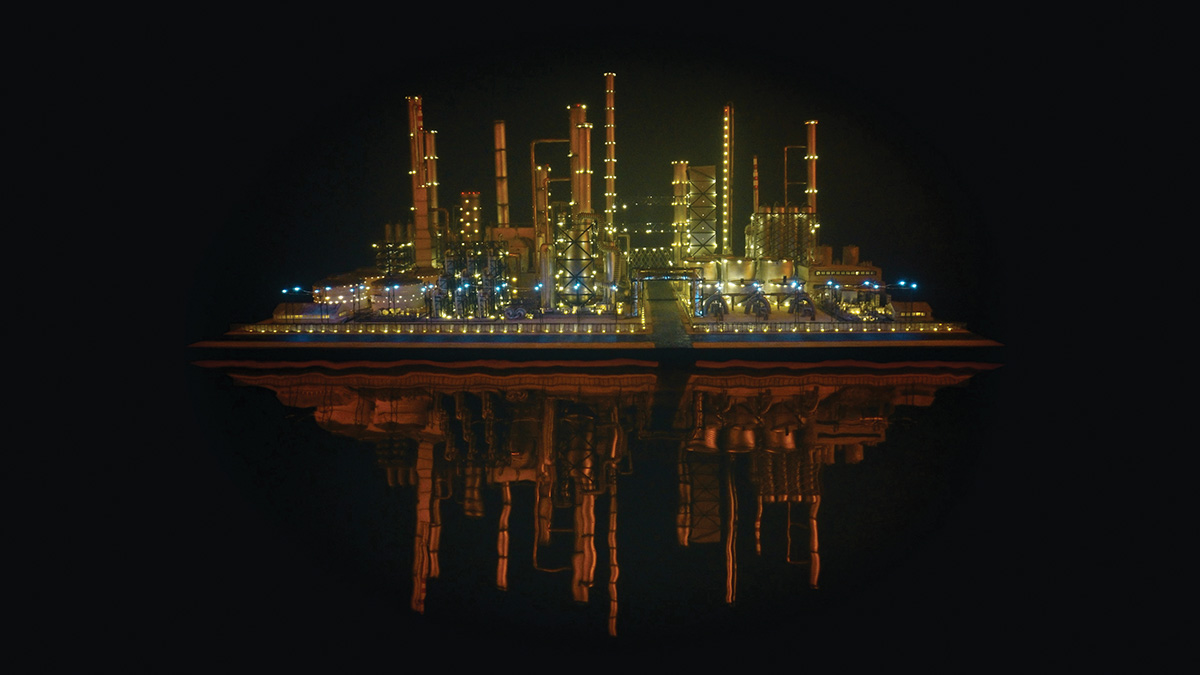

Monira Al Qadiri
Crude Eye
Film expérimental | 4k | couleur | 10:0 | Koweït, Allemagne | 2022
Growing up in Kuwait close to an oil refinery by the sea, the artist would create stories for the distant petroleum operation while passing by on a traffic bridge. As she envisioned an expansive panorama of lights, fire, smoke, and towers, Al Qadiri imagined it was a city-metropolis—"filled with beings and phantoms from another world.” This dream-like film hearkens back to these childhood memories, fusing eerie, slow views of a reconstructed miniature refinery with lines from poems about city lights and industrial landscapes. Crude Eye blurs reality with speculative memory, and we are unable to tell if the scene is a real place or a fantasy. The artist says: “The work attempts to reconcile a sense of childlike wonder with the toxic environmental destruction that the refinery inherently represents.”
Monira Al Qadiri (b. 1983) is a Kuwaiti visual artist born in Senegal and educated in Japan. Spanning sculpture, installation, film and performance, Al Qadiri's multifaceted practice is mainly based on research into the cultural histories of the Gulf region. Her interpretation of the Gulf's so-called "petro-culture" is manifested through speculative scenarios that take inspiration from science fiction, autobiography, traditional practices and pop culture, resulting in uncanny and covertly subversive works. She is currently based in Berlin.


Loukia Alavanou
On the Way to Colonus
VR vidéo 360 | mov | couleur | 20:0 | Grèce | 2021
Blind Oedipus, in older age, left Thebes as an exile accompanied by Antigone, who was both his daughter and sister. They sought refuge in Colonus of Athens. What if the tragic hero of Sophocles’ play 'Oedipus at Colonus' was a Romani nomad residing in today’s post-industrial outskirts of western Athens? OTWTC is a ‘docufictional’ VR film cast with Romani amateurs who live at the ghettoised toxic wastelands of Thriasian Plain, where Sophocles’ wandering hero is meant to have passed from. Consisted of a spatial sound design (ambisonics), the film's audio incorporates location sounds recorded inside the dwellings that merge “high” and “low” culture, often carrying with them the “eerie echoes” of dubbed TV series, speaking themselves about “Oedipal conflicts”, ‘absent fathers’, ‘incest’, murder and death.
Loukia Alavanou is a moving image artist and filmmaker. She is representing Greece at the 59th Venice Art Biennale with the exhibition “Oedipus in Search of Colonus. Alavanou holds an MA in Photography from the RCA in London. She was the winner of the 5th Deste Prize. In recent years, after receiving international acclaim, she started to be involved with the production of VR films and founded the first VR production company in Greece. She held a retrospective exhibition at State of Concept, Athens in 2018. For the years 2021 and 2022 Alavanou is a fellow artist at ONX Studio, organised by Onassis USA and the New Museum in NY. Alavanou’s work has been presented by institutions and festivals including KANAL Centre Pompidou, Accelerator, Stockholm, Gucci Garden, Kino Der Kunst, Palais de BOZAR, Palais de Tokyo, Athens Biennale, Moscow Biennale, Fiorucci Art Trust, The Museum of Cycladic Art, Benaki Museum. Her films are part of numerous collections including the Onassis Collection, the Dakis Joannou Collection, The Center for Art and Media Karlsruhe/ ZKM, PCAI/ Polyeco Contemporary Art Initiative.


Almourad Aldeeb
Flut
Doc. expérimental | 16mm | couleur | 11:25 | Syrie, Allemagne | 2022
Le 14 juillet 2021, la vallée de l'Ahr, en Rhénanie, a connu une catastrophe naturelle : une inondation a coûté la vie à plus de 130 personnes. La ville d'Ahrweiler ressemble à une ville fantôme - un spectacle dystopique. Abdo, un habitant de la ville, partage le chagrin de la perte et revit le sentiment de peur et d'impuissance. Pour Abdo, qui est né et a grandi à Alep/Syrie, ce n'est pas la première catastrophe.
Almourad Aldeeb (he/him) is a Syrian filmmaker based in Germany. He was born and raised in Homs, Syria 1991. Currently, he is studying film at the Academy of Media Arts in Cologne. His practice is a search for a poetic reflective expressions, and intense narrative forms..


Vito Alfarano, Francesco Biasi
THE PASSENGERS
Vidéo | hdv | couleur | 14:50 | Italie | 2023
Avec les détenus de la prison de Brindisi comme protagonistes, THE PASSENGERS parle de l'attente, ce moment où tout s'arrête, où l'on a le temps de réfléchir et de repartir en pleine conscience. Les passagers accueillent tout le monde dans leur wagon, l'important étant de se laisser porter par la puissance évocatrice de leurs récits. Ils racontent leur attente, leur rapport au temps, ils manifestent leur fragilité et en dansant ils s'amusent, ils jouent avec eux-mêmes. Entre lectures de passages écrits dans la cellule, musique entraînante et chorégraphie de groupe, les protagonistes libèrent tout le monde : parce que tout le monde est prisonnier de quelque chose qu'il porte en lui. Et le partage est l'outil qui permet de s'en libérer. La mise en scène est signée Vito Alfarano, tandis que la chorégraphie est un travail à quatre mains entre Alfarano lui-même et Francesco Biasi, le jeune chorégraphe de la compagnie. Les textes sont de Michele Caiulo, qui a écrit ses pensées et ses réflexions dans son journal pendant sa détention. Choisis par Vito Alfarano et réadaptés par Marcello Biscosi, ils sont devenus le guide du spectacle. Le projet bénéficie du soutien de la Garant des personnes soumises à des mesures de restriction de la liberté personnelle du Conseil régional de la Région des Pouilles et est réalisé en coopération avec la Direction de la Prison de Brindisi, Ministère de la Justice.
VITO ALFARANO _ Directeur artistique et chorégraphe Il a commencé sa carrière comme danseur indépendant en travaillant avec différents chorégraphes. Avec ses chorégraphies et ses scénographies, il a remporté les premiers prix lors de concours internationaux et de festivals de scénographie. Il est le directeur artistique d'AlphaZTL Company of Dynamic Art basée à Brindisi (Italie), qui s'occupe d'ART & SOCIAL avec de la danse contemporaine et de la screendance, et de BRINDISI PERFORMING ARTS, un festival d'inclusion sociale par le biais des arts du spectacle. ____________________________ FRANCESCO BIASI _ Vidéaste et chorégraphe Danseur, vidéaste et chorégraphe. Sa contamination entre la danse, la vidéo et la réalité caractérise sa recherche artistique. Il tente de transmettre à ses danseurs le pouvoir de l'interprétation personnelle afin que chacun puisse exprimer au mieux son âme.
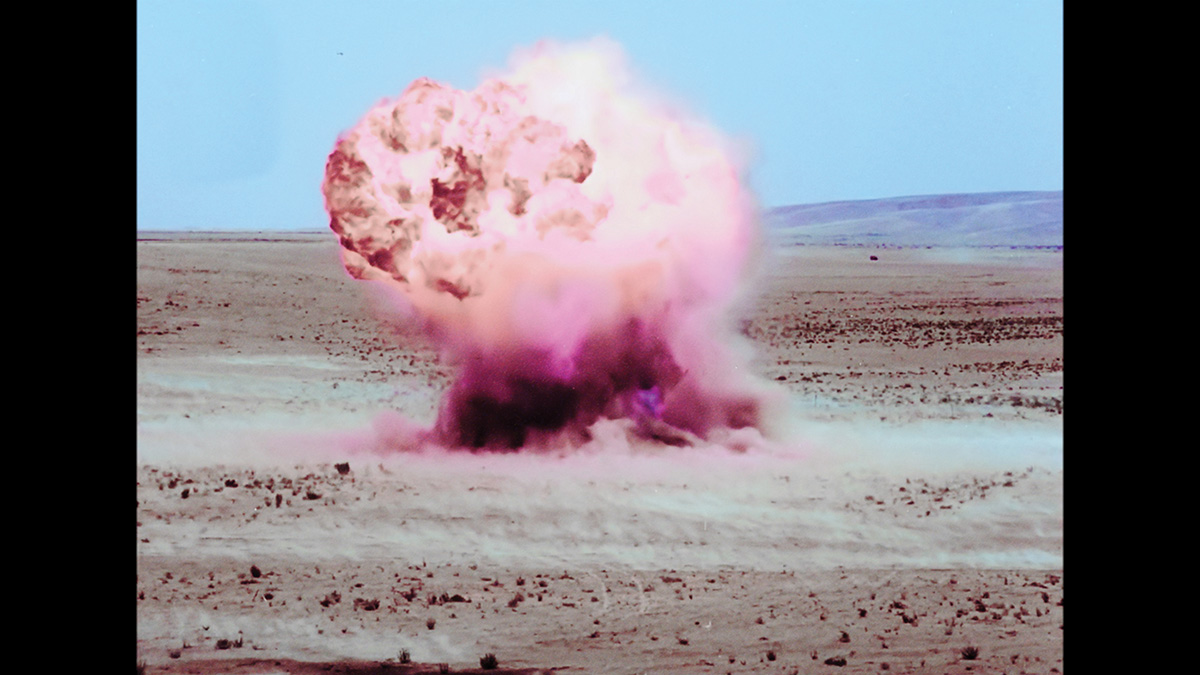

Kamal Aljafari
Paradiso, XXXI, 108
Film expérimental | mov | couleur | 18:40 | Allemagne | 2022
«It’s going to be quite soundless, the roar of our aircraft is drowning everything else. We are running straight into the most gigantic display of soundless fireworks in the world, and here we go to drop our bombs»
Kamal Aljafari is a Palestinian filmmaker. He attended the Academy of Media Arts in Cologne and now lives in Berlin, Germany. He has taught filmmaking at The New School in New York and the Deutsche Film- und Fernsehakademie, Berlin. He was also a Film Study Center Radcliffe Fellow at Harvard University. In 2021 Olhar de Cinema – Curitiba International Film Festival in Brazil devoted its Focus Section to his work. Most recent work, Paradiso, XXXI, 108, premiered at Corti d'Autore, in Locarno Film Festival 2022. He is currently completing “A Fidai Film”, and preparing a fiction film to be shot in Jaffa.


Alejandro Alonso, Alejandro Pérez
Terranova
Doc. expérimental | digital | couleur et n&b | 50:0 | Cuba | 2021
Cities do not repeat themselves; they transmute. The city of Havana is portrayed in Terranova as a phantasmagorical, magical, and sensory space. An urban landscape created through reflections, glimpses of other cities, and visions of the future.
Director and photographer. Graduated in the Documentary Filmmaking at the lnternational School of Cinema and TV (ElCTV) in San Antonio de los Baños, Cuba. His documentary "The Farewell" (2015) had its international premiere at lDFA; it was awarded for Best Film in the Aciertos category of FlCUNAM and obtained the Full Frame President Award. "Duel" (2016) premiered at Cinema du Réel; it won the award for Best Short Film at the 32nd Mar del Plata Film Festival and Best Short Film at the 58th Popoli Festival. His feature film "The Project" (2017) had its world premiere at Visions du Réel, it won the FlPRESCl Award at the 60 Dok Leipzig. "Terranova" (2020), a medium-length film co-directed with Alejandro Pérez, won the Ammodo Tiger for Best Short Film at the Rotterdam Festival. His latest film, "Abissal" (2021), had its premiere at Visions du Réel, won the Audience Award at Documenta Madrid, 2021 and won the Golden Dove Dok Leipzig, 2021. Between 2017 and 2019, coordinated the Alternative Film Master's program organized by the EICTV. His feature-length documentary project "The Star" was selected for the Residency at the Academy of Cinema in Madrid during 2021.
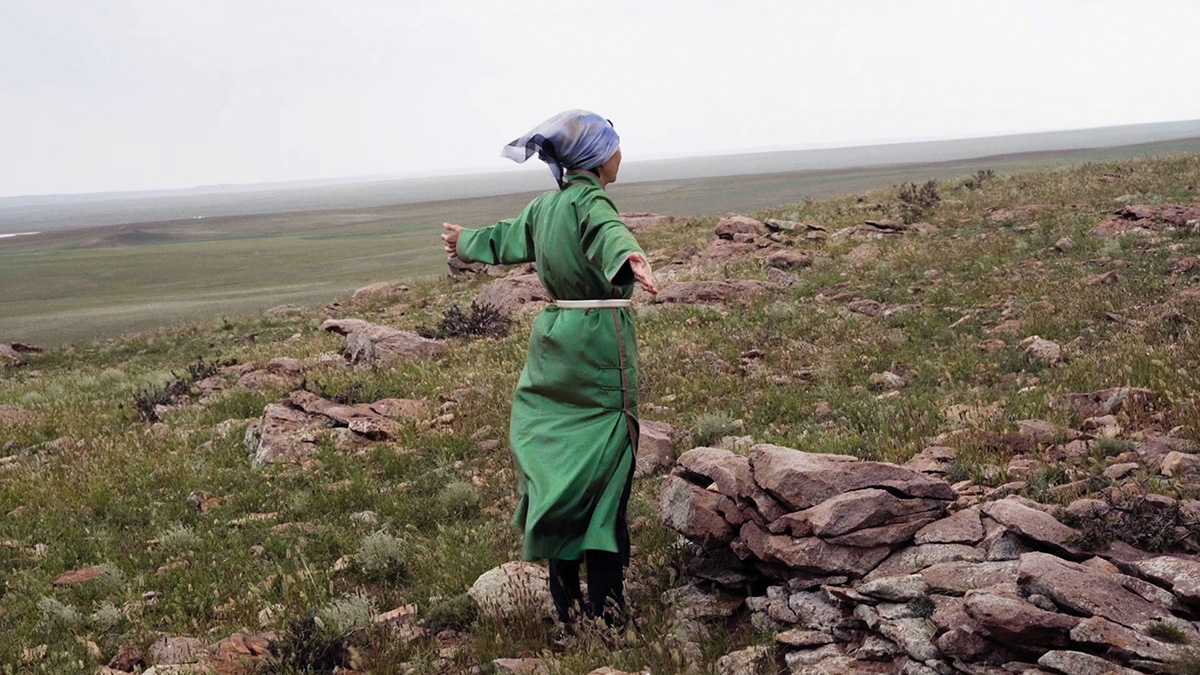

Udval Altangerel
The Wind Carries Us Home
Doc. expérimental | mov | couleur | 11:11 | Mongolie | 2022
Through rituals of birth and death, the filmmaker and her family reconnect with their ancestral land in the Gobi Desert.
Udval Altangerel is a Mongolian filmmaker based between Ulaanbaatar and Los Angeles. In her work she explores the themes of personal and national histories, language, and (home)land. Her work has screened at Locarno Film Festival, Images Festival, Alchemy Film & Moving Image Festival, and Tacoma Film Festival, where she received Honorable Mention for Best Documentary Short Film. She was selected to participate in Locarno Open Doors and the Flaherty Film Seminar. Udval received her MFA in Film Directing from California Institute of the Arts.
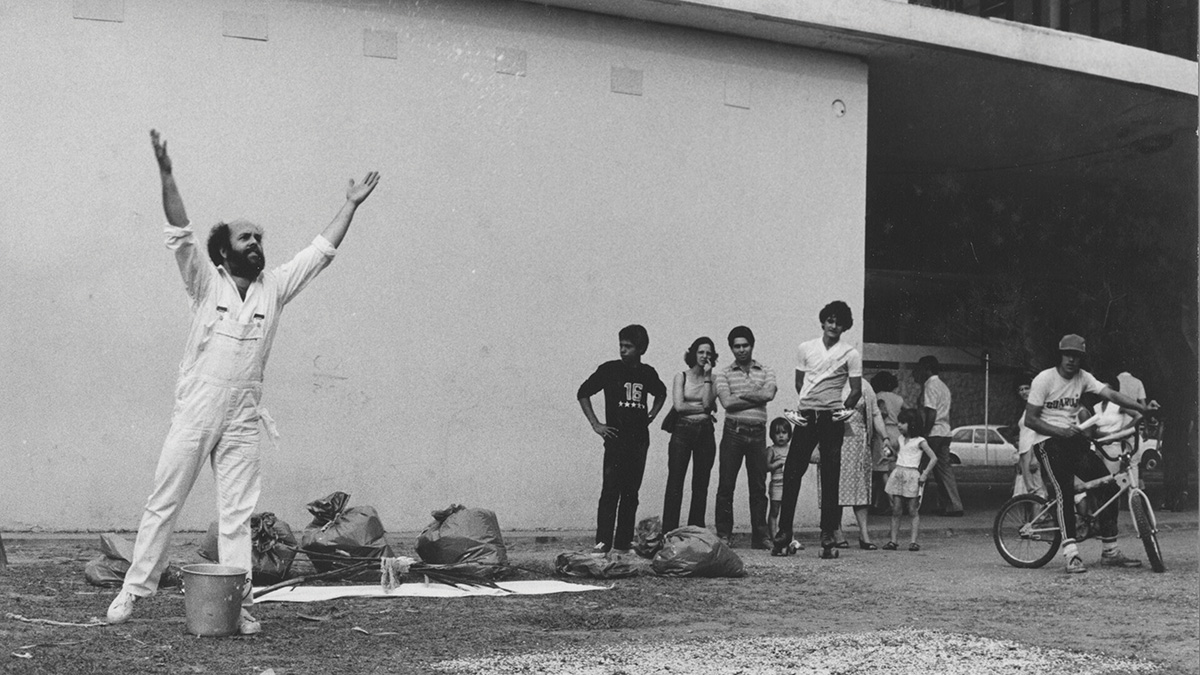

Luís Alves De Matos
A Casa de Dentro Carlos Nogueira
Documentaire | 0 | | 62:0 | Portugal | 2022
This documentary addresses the work of visual artist Carlos Nogueira – a multidisciplinary artist, and one of the leading contemporary Portuguese creators. It sheds light not only on his work, but also on his close relationship with his living and working space.
With a degree in filmmaking from the Escola Superior de Teatro e Cinema, Lisbon, since 1993, Lui?s Alves de Matos has collaborated in different contemporary creative projects. He then went on to make a number of documentary films about Portuguese artists. In 2001 he founded Amatar Filmes, continuing with the independent production and directing of documentaries in the field of art, as well as experimental films.
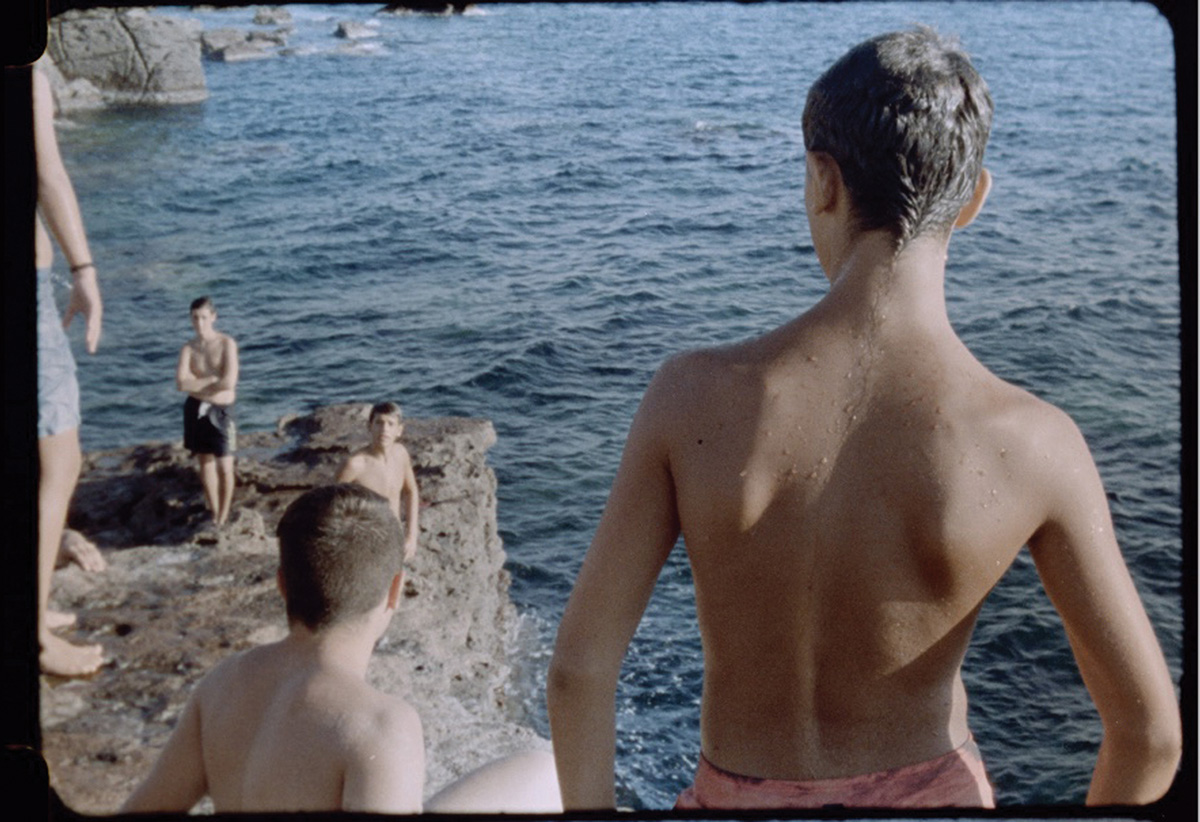

Marta Anatra
Progresso Renaissance
Doc. expérimental | 16mm | couleur | 20:0 | Italie | 2019
Portovesme, Sardaigne. Images d'un été passé. Les vagues de la mer s'écrasent sans cesse sur les rochers. Un groupe de garçons se rend à la plage à bicyclette, en passant devant des bâtiments industriels abandonnés qui annonçaient autrefois une nouvelle ère. Dans ce film cross-genre composé d'images d'archives et d'enregistrements 16 mm, le temps entre 1969 et le présent semble se confondre. Dans une région où le développement est au point mort, le groupe de garçons symbolise toute une génération.
Artiste visuelle, éditrice et réalisatrice, j'ai suivi une formation de peintre à l'Accademia di Belle Arti de Florence. Je vis et travaille à Marseille où j'ai suivi un master en film documentaire à l'université d'Aix-Marseille. J'ai également suivi une formation au Grenada Visual Centre à Manchester et à l'ISRE à Nuoro avec David et Judith McDougall. Le collectif Film Flamme-Polygone Etoilé et le Laboratoire L'Argent, dont je suis cofondatrice, ont joué un rôle déterminant dans mon travail en pellicule. Mes films indépendants ont été projetés dans des festivals internationaux tels que la Berlinale, le NYCIFF, le Festival des Peuples, Film Femmes Méditerranée, le SIEFF et l'ISREAL.


Carla Andrade
Ningún río me protexe de min
Doc. expérimental | 16mm | couleur et n&b | 27:27 | Espagne, 0 | 0
"No river protects me from myself" takes as its starting point the mysterious theft of filmed material shot in the Congo Basin rainforest. This accident offered a response to conflicts arising from the fragile and transubjective encounter with the “non-I”, which could only be practised or experienced; if one tries to virtualise it, it ceases to exist. The impossibility of representing a reality that is not one's own without creating distance or detachment, or conversely, taking control of it, leads to a backwards retreat in which, through conversations with my mother, I discover a fragmented and contradictory identity based on fragile foundations. This incessant external search for forms of knowledge that differ from the consensus—or compulsory—reality becomes internal.
An interest in the aesthetic experience and how it works as a transformer of conscience led Carla Andrade (Vigo, Spain, 1983) to study both a Degree in Audio-Visual Communication Studies and Philosophy, as well as an M.A in Artists’ Film and Moving Image at Goldsmiths University of London. This intersection between the means of visual expression and a field close to reflection is, precisely, the central aspect that defines her work. Travelling is also an important part of her process so she has carried out Artist Residencies in Iceland, Sweden, Nepal, Chile or Paris, among others. She has shown her work (both individually and collectively) in renowned contemporary art venues such as Guggenheim Museum of Bilbao, MARCO Vigo, Le 104 Paris, CaixaForum Barcelona, Tabacalera Madrid, La Casa Encendida Madrid, Bilbaoarte, Lux London or Tabakalera Donosti, etc; and in prestigious international Photography and Film Festivals such as PhotoEspaña, Mois de la Photo (Paris) or Encontros da imagem (Portugal); International Film Festival Rotterdam, Zinebi, PortoPostDoc, Courtisane, Ji.hlava, L’Alternativa Barcelona, Curtocircuito or Alchemy Film Festival. Furthermore, her work has been part of important international publications from South Korea, USA, Brazil or Spain and acquired by public and private art collections such as CA2M or CGAC. Likewise, her work has obtained awards including the First Prize of Visual Arts 2013 from Complutense University of Madrid, Emerging Artists Award Absolut 2013, Frac Vila Acquisition Award 2013 from Luis Adelantado Gallery, Women Award-Forum-Dialogue Alliance Francaise / Pilar Citoler 2012, Photography Award Madrid SUMMA 201, etc; and grants from Injuve, Institut Français, BilbaoArte Foundation, VEGAP, Agadic and the Scholarships for Abroad Artistic Creation Gas Natural Fenosa.